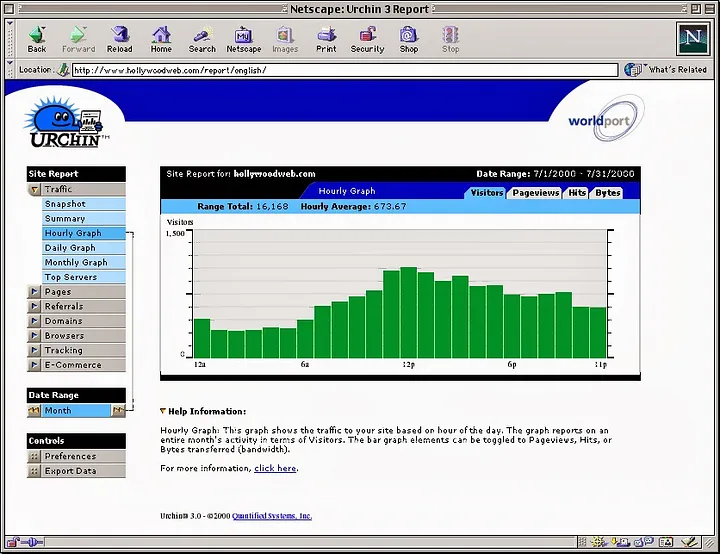The Early Stages of Web Analytics (Mid-1990s to Early 2000s)

- Web Counters Begin the Journey: Simple counters in the mid-1990s were the first step in tracking web page loads, a basic but essential start. They were very rudimentary and I would regulary press F5 to boost my hits! (Bare in mind I was 10 when I had my first website… I’d still do it now though if it was possible 😉 )
- Server Log Analysis: Provided more insights into visitor behavior, with tools like WebTrends.
- Introduction of JavaScript Tagging: Late 1990s saw the advent of JavaScript tagging, which was a step forward in understanding what happened on your site.
- Launch of Urchin in 1998 (you’ll see what happens to this soon).
Introduction of Google Analytics (Early to Mid-2000s)

Image Credit Also check out the history of Urchin on that page
- Aquisition of Urchin by Google: Perhaps the most “advanced” (we’d laugh now at the capabilities) at the time, Urchin was acquired by Google. It continued to be available for sale until 2012. I had a chance to use it in my career, but by that time, it already functioned similarly to Google Analytics. When I was 14, I worked at a competitor company to Urchin called AllCount. Unfortunately, it didn’t get acquired by Google, which is why I am writing this at my desk rather than in my private jet.
- Focus Shifts to User Experience: Analytics began to concentrate on understanding the user experience, moving beyond just counting page views… No more repeatadly hitting F5 for me 🙁
- Real-Time Analytics: Tools started offering real-time data.
Integration with Marketing and Social Media (Late 2000s to Early 2010s)
- Marketing Campaign Analysis: Web analytics began to play a crucial role in evaluating the effectiveness of online marketing campaigns “UTM” is an arcnoym for “Urchin Tracking Module” ?
- Emergence of Social Media Analytics: With the rise of platforms like Facebook and Twitter, analytics tools started to incorporate automated tracking. (Unfortunately doesn’t work so well anymore).
- Mobile Web Analytics: The growing importance of mobile internet use led to the development of mobile-specific analytics, focusing on mobile websites and later, mobile apps.
Big Data and Advanced Analytics (Mid-2010s to Late 2010s)
- Big Data Integration: The explosion of big data technologies meant that businesses could now analyze massive, complex datasets, leading to more nuanced insights or just a massive mess no one could actually use (wait… that’s still happening now).
- Predictive Analytics and Machine Learning: Advanced techniques, including machine learning algorithms, were employed to predict future trends and user behaviors.
- Personalization and Segmentation: Segmenting users based on their behavior, demographics, and other criteria, enabling highly personalized user experiences.
AI, Privacy, and Cross-Platform Challenges (Late 2010s to Present)
- Artificial Intelligence and Automation: AI technologies have been increasingly integrated into web analytics for automated data analysis, anomaly detection, and generating insights. With still currently so-so results most of the time.
- Privacy Regulations and Data Compliance: The introduction of GDPR in Europe, CCPA in California, and other privacy laws worldwide, forced a reevaluation of data collection methods. Some new analytics tools appeared and others adapted or will adapt to ensure compliance.
- Cross-Device and Multi-Platform Tracking: With almost every device even your toothbrush and toilet brush being connected ot the internet, customisation and implementation across all platforms is now possible even with GA4 just don’t expect to get any easy insights anymore without some serious customisation.
Future Trends and Evolving Landscape
- Voice Search and Conversational Analytics: With the rise of voice-activated devices and AI assistants, analytics is expanding to understand how users interact through voice.
- Advanced User Privacy Techniques: As privacy concerns continue to grow, there’s a trend towards more transparent and ethical data collection methods, including the use of anonymization and privacy-by-design principles.
- Integration with Other Business Systems: Web analytics is increasingly being integrated with other business systems like CRM and ERP (which could and should of happened years ago but anyway).
